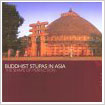India
Mahabodhi Temple in Bodhgaya
The Mahabodhi Temple in Bodhgaya, in the Indian state of Bihar, India is Buddhisms' most sacred place. This 170-feet-high temple stands majestically in the form of soaring slender pyramid on a base of 48 square feet. Built about 1,500 years ago, this architecturally beautiful temple attracts Buddhist pilgrims from world over, besides a large number of tourists interested in history and Buddhism. This temple in Bodhgaya, where the Buddha found enlightenment after years of wandering in search of truth, was formally dedicated as the Unesco's World Heritage site, in February, 2004. Read more
Pakistan
 Sirkap
Sirkap
Sirkap is an archaeological site on the bank opposite to the city of Taxila, Punjab, Pakistan. The Greco-Bactrian king Demetriusin built the city in 180 BC after he invaded India. It was rebuilt by king Menander according to the Greek fashion. Read more
 Taxila
Taxila
Taxila is one of the most famous archaeological sites in the world. For sometime, it has been the center of Buddhism, the world famous Gandhara sculpture and the center of learning and culture. Read more
 Tahkt-i Bahi
Tahkt-i Bahi
The most striking Buddhist site I visited was Tahkt-i Bahi near Mardan. This site was a large monastery located on a hilltop, occupied from the 1st to 7th century A.D. Much of the friezes and statuary was removed between 1907 and 1913, some of which can be seen on site and in museums in Pakistan. Read more
Indonesia
 Borobudur
Borobudur
Borobudur Temple is one of the greatest Buddhist monuments in the world. This colossal relic of Borobudur Temple was built by Sailendra dynasty between 750 and 842 AD; 300 years before Cambodia’s Angkor Wat, 400 years before work had begun on the great European cathedrals. Read more
China
 Yungang Grottoes
Yungang Grottoes
The Yungang Grottoes are one of the three major cave clusters in China, punctuate the north cliff of Wuzhou Mountain, Datong. The area was excavated along the mountain, extending 1 km (0.62 miles) from east to west, revealing 53 caves and over 51,000 stone statues. Read more
Nepal
 Lumbini: The garden where Prince Siddhartha was born
Lumbini: The garden where Prince Siddhartha was born
Prince Siddhartha was born in a lovely garden called Lumbini, who later became Gautama Buddha, the founder of Buddhism, which was destined to be the prevalent religion in Asia. Read more
Japan
 Tenryu-ji
Tenryu-ji
Tenryu-ji is a Zen temple located on a slope of the Arashiyama district of Kyoto. It is ranked first among the city's "Five Great Zen Temples". Also called "heavenly dragon temple", the temple is listed on the UNESCO World Heritage list and is the head temple of the Tenryu-ji branch of Rinzai Zen Buddhism. Read more
 Kinkaku-ji
Kinkaku-ji
Its famous Golden Pavilion (Kinkaku) — actually a pagoda made to house the sacred relics of the Buddha — has given this temple the popular name of Kinkaku-ji ("Temple of the Golden Pavilion"), however the official name of this branch temple of the Rinzai-sect Zen temple of Shôkoku-ji is Rokuon-ji. The temple was designated as a UNESCO World Heritage Site in 1994. Read more
 Nishi Hongwanji
Nishi Hongwanji
The temple is the head temple (Honzan) of the Honganji branch of Jodo-Shinshu. Its complete name is Jodo-Shinshu Honganji-ha Honganji (Honganji of the Honganji branch of Jodo-Shinshu), shortened to Hompa-Honganji. Read more
 Ryoan-ji
Ryoan-ji
Ryoanji islocated in northwestern Kyoto. It is a temple belonging to the Myoshinji school of the Rinzai branch of the Zen sect. In December 1994, this temple was designated as World Heritage by UNESCO. The earliest temple recorded on this site dates from 983, though it was originally the estate of one of the branches of the Fujiwara family during the Heian period. Read more
Thailand
 Ayutthaya
Ayutthaya
The Phra Nakhon Si Ayutthaya or Ayutthaya in short, is one of Thailand's historical and majestic highlights. Serving as the Thai capital for 417 years (1350 1767: Kingdom of Ayutthaya), it was once glorified as one of the biggest cities in Southeast Asia. Read more
 Sukhothai
Sukhothai
Sukhothai (literally Dawn of Happiness), founded in 1238, was the capital of a Thai kingdom considerably larger than Thailand is now, for approximately 120 years. Today, it's just the capital of Sukhothai Province with an area of 6,596sqkm (2,546sqmi), approximately 427km (267mi) north of Bangkok. Read more











